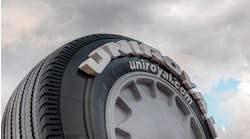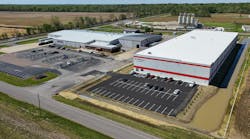Groupe Michelin held its 12th annual Michelin Challenge Bibendum (MCB) in Chengdu, China, in November. The event brought together members of both the private and public sectors to examine sustainable mobility; this year’s conference focused on innovation in mobility, and how it can drive growth and urban well-being.
MCB is a Global Summit, with a mixture of a high-technology transportation trade show, scientific presentations and hands-on demonstrations of electric and hydrogen-powered vehicles, many of which are experimental in nature.
A highlight by Michelin for this year’s event was the company’s unveiling of its Green Paper. MCB produced the Green Paper, which it says is a collective work by numerous entities. The Green Paper includes a disclaimer that says “not all parties agree with every word in this book.”
The Green Paper is a permanent platform dedicated to the mobility of the future. Its goal is for the paper to become a global benchmark in this area.
It lays out five essential game changers that MCB believes should be implemented in order to address current urban mobility challenges.
- Setting ambitious CO2 emissions reduction targets.
- Creating ultra-low emissions zones (ULEZs).
- Reinventing last-mile delivery logistics.
- Developing creative door-to-door transport solutions for people.
- Mobilizing private investment for sustainable infrastructure.
The paper also describes five actionable levers for deploying game changers. These levers must be activated simultaneously in order to achieve the desired results, according to MCB.
- Encourage the emergence of innovative ecosystems to support the development of new sustainable mobility products and services.
- Support tomorrow’s winning technologies, such as electro-mobility solutions, information and communication technologies, intelligent transportation systems and large database management.
- Facilitate the introduction of new economic instruments.
- Introduce targeted public policies that support the emergence of new solutions.
- Broadly deploy the proposed solutions.
Jean-Dominique Senard, CEO of Groupe Michelin, believes MCB has a commitment “to federating stakeholders in the mobility sector, with the goal of imagining and creating the mobility of the future.” He told attendees that he hopes worldwide political leaders will read the document and take action.
[PAGEBREAK]
“I don’t know any government in the world that can ignore that paper,” Senard said. “With this paper, we are changing the world, especially in the area of urban mobility.”
The conference also featured an exhibition area where companies and governments displayed their ideas for future transportation to enhance mobility. Although not a platform for selling tires, Michelin used the event to showcase some of its tires, including the new Selfseal tires for the European marketplace that will be launched next year (see sidebar).
The company also displayed its Pilot Sport EV tire, Premier A/S tire, AxioBib IF900/65R46 farm tire with Ultraflex technology (which the company says is the world’s largest tractor tire), and NZG aircraft tires.
“Promoting sustainable mobility at the global level is the slightly gargantuan goal of the MCB,” said Senard. “But it’s more than a dream or a utopia.
“Today and every day, technological innovation is helping to improve the environmental, safety and cost performance of all means of transportation, whether individual or collective.”
Michelin has invested two billion euros in research and development during the last three years, with 6,000 people working in this area. Senard said Michelin is issued 250 patents each year, and that its total patent portfolio has tripled over the last 10 years.
Michelin is “only one of two tire companies that produce all categories of tires.” The company has tires in the Tier Two and Tier Three categories because customers want these tires, he added.
The conference had roughly 5,000 attendees, including car makers, OEMs, public and private sector operators, academics, research institute members, political officials and representatives from non-governmental organizations. In total, approximately 50 companies participated either as sponsors or corporate members of the event.
Tariffs and more
During a break at the MCB, MTD had the opportunity to talk with Pete Selleck, Michelin North America Inc. chairman and president.
Selleck said Michelin has maintained a “neutral” stance on the Chinese tariff and countervailing duties investigation by the International Trade Commission, but did say “we are advocates of free trade.”
He said the company “met expectations” with the launch of its Primacy tire this year, but admitted there were supply challenges. The company plans to re-launch the product in 2015 and better communicate the benefits of it to consumers.
When asked about how the MCB affects the North American market, Selleck said it allows the company to communicate that “a tire is more than a pric Michelin Selfseal tires will be launched in Europe in 2015
Expect them in the U.S. within three years
Groupe Michelin will be introducing a line of self-sealing passenger and light truck tires for the European market in 2015, beginning with the original equipment market.
The tires will then be introduced at the OE level in the United States within three years, according to Michelin officials. The tires were on display at Michelin’s Challenge Bibendum last month in Chengdu, China. The company did not disclose which automobile makers were going to use the new tire.
According to Michelin’s display at the event, the tires will self-repair a tread-area puncture under six millimeters (less than 1/4-inch) through the use of a sealant material of natural rubber. The material is in a protective layer below the tread area and will not affect speed ratings of the tire.
The company’s research shows that a puncture occurs, on average, once every 75,000 kilometers (46,600 miles) in European countries and once every 3,000 kilometers (1,860 miles) in certain Southeast Asian countries. No figures were given for North America. Michelin believes its new Selfseal tires will allow carmakers to eliminate spare tires and jacks, thus saving weight and allowing additional fuel savings.
Two different passenger tires, a Selfseal Primacy 3 and Selfseal Pilot Sport 3, were displayed, as well as a light truck tire. The technology differs from the company’s Uniroyal NailGuard technology, which evolved from Uniroyal Tire Co.’s Royal Seal technology.e and mileage warranty. It is a product that influences the environment.”
Selleck believes consumers want more and the industry should do more to explain the benefits of the products to them. ■
[PAGEBREAK]
Michelin Selfseal tires will be launched in Europe in 2015: Expect them in the U.S. within three years
Groupe Michelin will be introducing a line of self-sealing passenger and light truck tires for the European market in 2015, beginning with the original equipment market.
The tires will then be introduced at the OE level in the United States within three years, according to Michelin officials. The tires were on display at Michelin’s Challenge Bibendum last month in Chengdu, China. The company did not disclose which automobile makers were going to use the new tire.
According to Michelin’s display at the event, the tires will self-repair a tread-area puncture under six millimeters (less than 1/4-inch) through the use of a sealant material of natural rubber. The material is in a protective layer below the tread area and will not affect speed ratings of the tire.
The company’s research shows that a puncture occurs, on average, once every 75,000 kilometers (46,600 miles) in European countries and once every 3,000 kilometers (1,860 miles) in certain Southeast Asian countries. No figures were given for North America. Michelin believes its new Selfseal tires will allow carmakers to eliminate spare tires and jacks, thus saving weight and allowing additional fuel savings.
Two different passenger tires, a Selfseal Primacy 3 and Selfseal Pilot Sport 3, were displayed, as well as a light truck tire. The technology differs from the company’s Uniroyal NailGuard technology, which evolved from Uniroyal Tire Co.’s Royal Seal technology.



